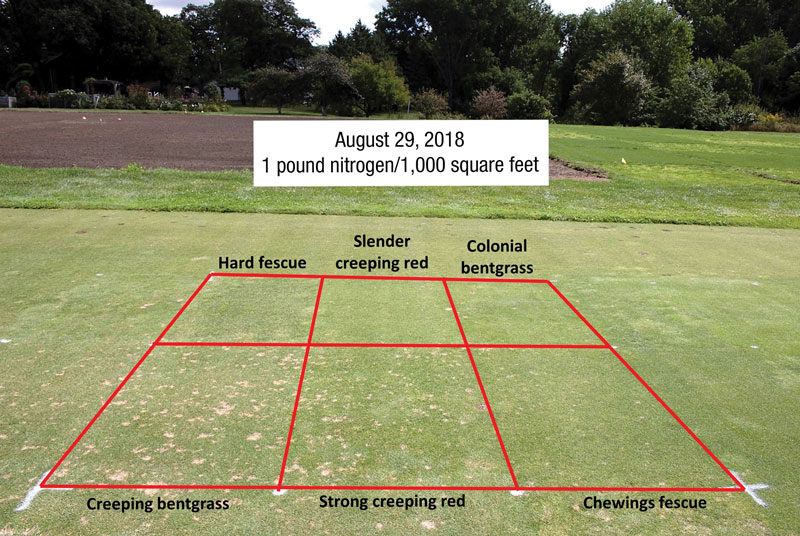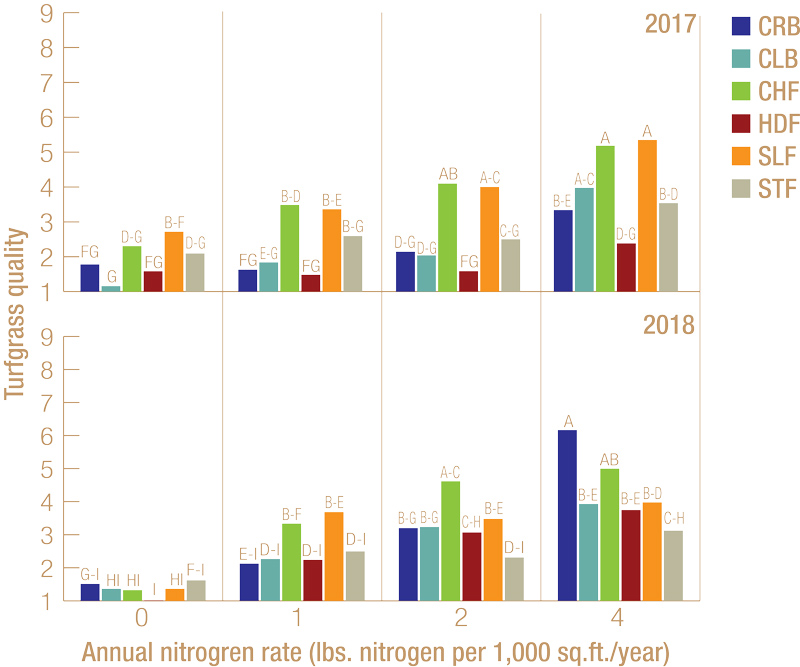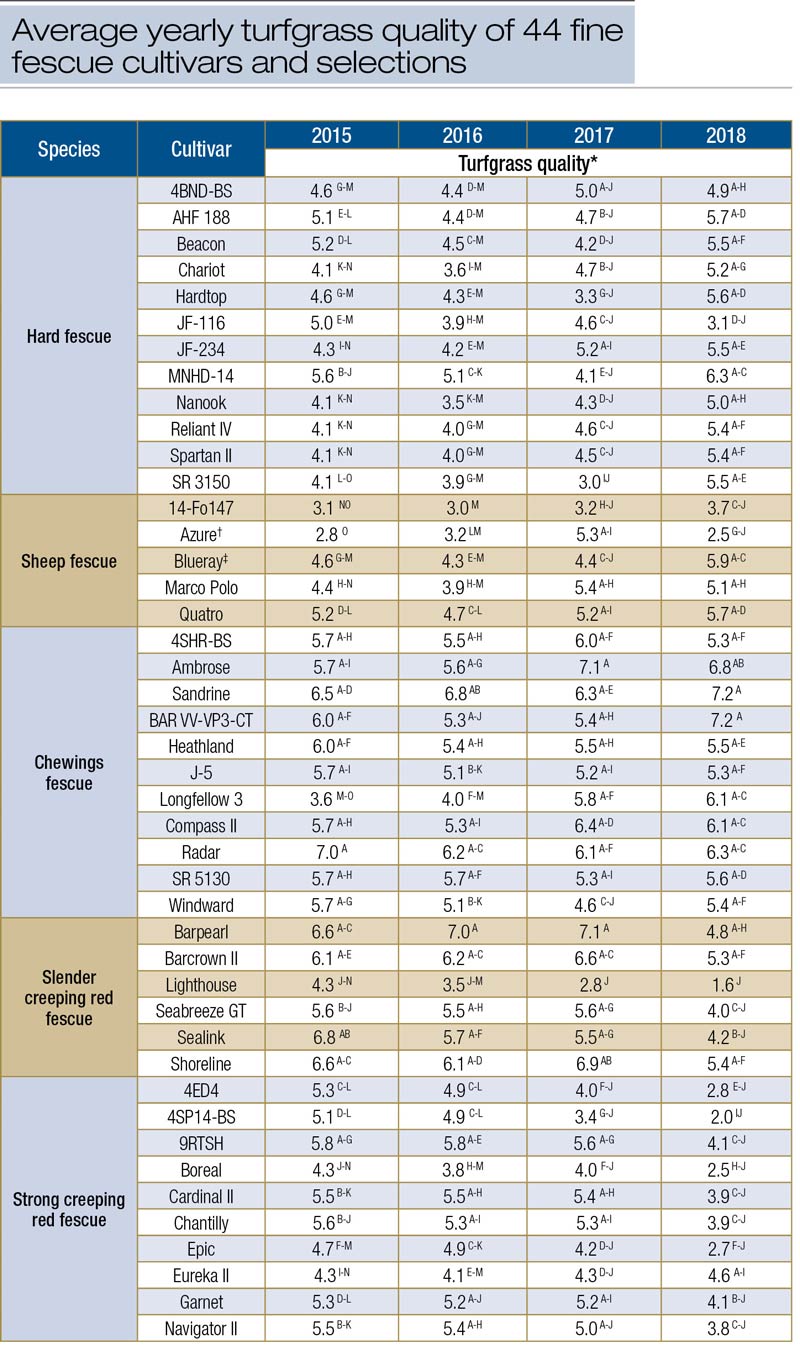
Figure 1. Plots of creeping bentgrass, colonial bentgrass, Chewings fescue, hard fescue, slender creeping red fescue and strong creeping red fescue from Study 1 at the University of Minnesota-St. Paul campus on Aug. 29, 2018. Plots seen here were treated with 1 pound of nitrogen/1,000 square feet annually. Photo courtesy of Dominic Petrella
Editor’s note: This research was partially funded by GCSAA through a grant from the GCSAA Foundation.
One way to reduce inputs on the golf course is to use improved turfgrass species and/or cultivars that require fewer inputs and are more pest-resistant. In the north-central United States, creeping bentgrass (Agrostis stolonifera L.) and annual bluegrass (Poa annua L.) are the predominant turfgrasses on putting greens. A drawback these grasses share is the need for greater inputs to maintain a high-quality putting green, especially when annual bluegrass is maintained as a desired species. Turfgrass breeders have also made strides in improving resistance to dollar spot (Clarireedia species) in new creeping bentgrass cultivars (4), but superintendents still rely on fungicides to control other diseases, such as snow molds (Microdochium and Typhula species). A way to potentially reduce inputs is to use alternative turfgrass species that function well under minimal management.
Fine fescues (Festuca species), a group of lower-input turfgrasses (1), have been shown to provide acceptable performance over more traditional turfgrasses in golf course fairways (5) and out-of-play golf course roughs (2). The fine fescue species that could be used on golf courses include strong creeping red fescue (Festuca rubra L. subspecies rubra Gaudin), slender creeping red fescue (Festuca rubra L. subspecies littoralis (G. Mey.) Auquier), Chewings fescue (Festuca rubra L. subspecies commutata Gaudin), hard fescue (Festuca brevipila Tracey) and sheep fescue (Festuca ovina L.).
Editor’s note: GCM has published ample recent research on fine fescue use on golf courses. Find clarified taxonomic classification, establishment and management recommendations, information on biotic and abiotic stresses, and more.
These grasses have been used extensively on putting greens in Europe for centuries and are known for their greater disease resistance as well as improved tolerance to drought and lower fertilizer needs. Researchers compared the different fine fescues with creeping bentgrasses maintained as putting greens in Minnesota and found that green speeds were similar on fine fescue and creeping bentgrass greens (3). However, we currently have little information on basic management practices for fine fescues on putting greens in the U.S.
The objectives of this research were: 1) to compare fine fescues and bentgrasses maintained as low-input putting greens managed with either low, moderate or high amounts of annually applied nitrogen in Minnesota, and 2) to evaluate multiple cultivars of fine fescues for putting green performance when maintained under low-input conditions.
Methods
We seeded two separate studies (Study 1 and Study 2) in 2014 at the Turfgrass Research, Outreach and Education Center at the University of Minnesota-St. Paul campus on a USGA root zone.
In Study 1, we seeded plots of Penncross creeping bentgrass, Greentime colonial bentgrass (Agrostis capillaris L.), SR 5130 Chewings fescue, Shoreline slender creeping red fescue, Chantilly strong creeping red fescue and MNHD-14 hard fescue. In 2015 and 2016, plots were maintained with a single application of 1 pound nitrogen/1,000 square feet (48.82 kilograms/hectare) in spring and were mowed at 0.200 inch (5.08 millimeters) three days per week with a walk-behind reel mower.
Researchers have previously shown that when the fine fescues are maintained at a higher-than-normal putting green height, they still maintain similar ball speed and performance to creeping bentgrass maintained at 0.125 inch (3.175 millimeters) (3). This is more than likely due to the more upright growth habit of the fine fescue species.
Beginning in 2017, plots of the different turfgrass species received a total of 0, 1, 2 or 4 pounds of nitrogen/1,000 square feet (0, 48.82, 97.64 or 195.29 kilograms/hectare) annually (25% granular urea, 75% granular methylene urea). The total amount of nitrogen was split equally across four dates beginning on or near the end of May. Plots were only irrigated under excessive drought. The treatments were repeated in 2018. For Study 1, we took digital pictures to monitor turfgrass density (turfgrass cover), rated turfgrass quality, and monitored for disease.
In Study 2, we seeded plots of 44 fine fescues — 12 hard fescues, five sheep fescues, 11 Chewings fescues, six slender creeping red fescues and 10 strong creeping red fescues — to determine whether some species/cultivars perform better when maintained as a low-input putting green over a period of four years. These fine fescues were mowed three days per week at 0.200 inch and were fertilized every month during the growing season with approximately 0.30 pound of nitrogen/1,000 square feet (14.64 kilograms/hectare) (25% granular urea, 75% granular methylene urea). Plots were only irrigated under excessive drought. For Study 2, we rated turfgrass quality monthly during the growing season from 2015 to 2018.
Results and discussion
Study 1: Turfgrass density
In 2017, more nitrogen did not significantly change the density of creeping bentgrass, even when compared with unfertilized creeping bentgrass. However, for Chewings, slender and strong creeping red fescue, all nitrogen treatments increased density compared with unfertilized plots. For hard fescue, only the high-nitrogen treatment of 4 pounds of nitrogen/1,000 square feet increased density compared with unfertilized plots. At 1 pound of nitrogen/1,000 square feet, slender creeping red fescue was significantly denser than creeping bentgrass, and at 2 and 4 pounds of nitrogen/1,000 square feet, both Chewings and slender creeping red fescue were significantly denser than creeping bentgrass.
Results in 2018 for turfgrass density were similar to those in 2017, but in 2018, slender creeping red fescue had significantly greater density than hard and strong creeping red fescue (Figure 1, top).
Study 1: Turfgrass quality
In 2017, 4 pounds of nitrogen/1,000 square feet increased quality for creeping bentgrass compared with both 1 and 2 pounds, but even at 4 pounds, creeping bentgrass quality was still lower than what is considered acceptable (Figure 2, below). For Chewings fescue in 2017, there was no significant difference between turf treated with 2 and 4 pounds of nitrogen/1,000 square feet, both of which significantly improved turfgrass quality compared with unfertilized plots and plots treated with 1 pound of nitrogen/1,000 square feet. Slender creeping red fescue plots were similar to those of Chewings fescue, but slender creeping red fescue treated with 4 pounds of nitrogen/1,000 square feet was the best overall in 2017. For both hard and strong creeping red fescue, there were no significant differences in turfgrass quality, regardless of nitrogen treatment. Again, both Chewings and slender creeping red fescue outperformed creeping bentgrass, regardless of the amount of nitrogen, and both hard and strong creeping red fescue had significantly lower turfgrass quality than Chewings and slender creeping red fescue.

Figure 2. Turfgrass quality of creeping bentgrass, colonial bentgrass, Chewings fescue, hard fescue, slender creeping red fescue and strong creeping red fescue treated with 0, 1, 2 or 4 pounds of nitrogen/1,000 square feet annually in 2017 and 2018. Means followed by the same letter(s) are not significantly different.
In contrast to the 2017 results, treating creeping bentgrass plots with 4 pounds of nitrogen/1,000 square feet in 2018 produced better turf quality than the other nitrogen treatments, and these plots also had the best overall turfgrass quality in 2018. For hard, Chewings and slender creeping red fescue, all nitrogen treatments improved turfgrass quality compared with unfertilized plots, and treating with 1, 2 or 4 pounds of nitrogen/1,000 square feet resulted in no significant difference in turfgrass quality for these species. Strong creeping red fescue was the only fine fescue that did not show improved quality with any of the nitrogen treatments.
While Chewings and slender creeping red fescue performed better than creeping bentgrass overall in this study, turfgrass quality for these species was still below what many would consider acceptable. Reduced expectations for aesthetics are needed for grasses like these, especially if they are being managed with little input.
Study 1: Disease incidence
The primary reason creeping bentgrass density and quality were reduced in 2017 was because of greater dollar spot incidence across all nitrogen treatments compared with the other turfgrasses we evaluated. Of the fine fescues, strong creeping red fescue had the most dollar spot in 2017, and the other fine fescue species had very little dollar spot. Dollar spot was more prevalent in 2018, and even the high rate of 4 pounds of nitrogen/1,000 square feet only reduced dollar spot for strong creeping red fescue. As in 2017, at the lower rates of nitrogen we tested, Chewings, hard and slender creeping red fescue had significantly less dollar spot than creeping bentgrass in 2018 (Figure 1, top).
One disease that had a greater impact on the fine fescues in 2018 was summer patch. All the fine fescues were affected by summer patch in 2018, regardless of the amount of nitrogen we applied, and slender creeping red fescue plots had more summer patch — although not significantly more — than the other fine fescues. Because the area in this study had been creeping bentgrass, some creeping bentgrass came back into the fine fescue plots. Hard and strong creeping red fescue plots had the most creeping bentgrass contamination at the end of the experiment, regardless of nitrogen treatment. Controlling creeping bentgrass as a weed would be important if a bentgrass green were to be converted to fine fescue.
Study 2
Some of the fine fescues tested in our second study performed better than others when maintained as low-input greens (Table 1, below). Many hard and sheep fescues had the worst turf quality in the first year of the study, but by 2018, many hard and sheep fescues were not significantly different from the best fine fescues, such as Sandrine Chewings fescue. Most of the Chewings fescues were rated among the best each year of Study 2, with Ambrose, Sandrine, BAR VV-VP3-CT and Radar having excellent turfgrass quality throughout the study.

*Turfgrass quality ratings were acquired monthly from May to October during each year using a 1-9 scale; 9 is the best turfgrass quality and 6 is acceptable quality.
†Sheep fescue Azure is botanically a blue sheep fescue (Festuca ovina var. glauca).
‡Sheep fescue Blueray is sometimes classified as an American sheep fescue (1).
Table 1. Average yearly turfgrass quality of 44 fine fescue cultivars and selections maintained as a putting green from 2015 to 2018 in St. Paul, Minn. Click on table to enlarge.
Based on these results, Chewings fescues would be the best fine fescue to choose for a low-maintenance putting green in the north-central U.S. Although some cultivars did perform well, greater knowledge of which species are suited for low-input putting greens in the U.S., and more interest from golf course superintendents, should lead to new putting green-specific fine fescue cultivars with superior performance in the U.S.
Conclusions
When maintained at low or moderate rates of nitrogen, the top-performing fine fescue species were slender creeping red fescue and Chewings fescue. Although the fine fescues — except for strong creeping red fescue — had greater tolerance to dollar spot, management of summer patch disease would be necessary for a fine fescue putting green, particularly if slender creeping red fescue were the predominant species on the green. Overall, Chewings and slender creeping red fescue maintained with low-input management outperformed creeping bentgrass — primarily because they had less disease — potentially leading to a reduction in reliance on fungicides.
The overall results from the two studies indicate that in the north-central U.S., Chewings and slender creeping red fescue could be used as turfgrasses for low-input putting greens.
Editor’s note: Researchers outline proper establishment, mowing and fertility practices for successful use of fine fescues throughout the golfscape in Fine fescues on golf courses: Availability, establishment, management.
Acknowledgments
This work was funded by the Minnesota GCSA and Minnesota Agricultural Experiment Station Project No. MIN-21-051. This research was originally published as: Exploring fine fescues as an option for low-input golf greens in the north-central USA. Crop Science 2021 1-14 (https://doi.org/10.1002/csc2.20390).
The research says ...
- The two most commonly used turfgrasses for putting greens in the north-central U.S. are creeping bentgrass and annual bluegrass, which require high levels of inputs to maintain quality standards.
- Plots of several fine fescue cultivars were established in Minnesota in 2014 and later tested for turf density, quality and disease resistance in 2017 and 2018.
- Slender creeping red fescue and Chewings fescue were the top-performing species at low or moderate rates of nitrogen.
- Because these species had less disease, their use may reduce golf course reliance on fungicides.
Literature cited
- Braun, R.C., A.J. Patton and E. Watkins et al. Fine fescues: A review of the species, their improvement, production, establishment, and management. Crop Science 60:1142-1187 (https://doi.org/10.1002/csc2.20122).
- Cavanaugh, M., E. Watkins, B. Horgan and M. Meyer. 2011. Conversion of Kentucky bluegrass rough to no-mow, low-input grasses. Applied Turfgrass Science 8(1)1-15 (https://doi.org/10.1094/ATS-2011-0926-02-RS).
- Horgan, B.P., E. Watkins and A.B. Hollman 2012. Alternative grass species for use on low-input putting greens. Paper presented at the Third European Turfgrass Society Conference, Kristiansand, Norway.
- Thompson, C., Q. Zhang, M. Kennelly et al. 2019. The dollar spot susceptibility of 25 bentgrasses is consistent across five states in the central USA. Crop, Forage & Turfgrass Management 5(1)1-4 (https://doi.org/10.2134/cftm2018.09.0075).
- Watkins, E., A.B. Hollman and B.P. Horgan. 2010. Evaluation of alternative turfgrass species for low-input golf course fairways. HortScience 45(1):113-118 (https://doi.org/10.21273/HORTSCI.45.1.113).
Dominic Petrella is a researcher in the Department of Horticultural Science at the University of Minnesota, St. Paul, Minn. Sam Bauer is the founder and owner of Bauer Turf LLC, a consulting, education and research company. Brian Horgan is a professor and chairperson in the Department of Plant, Soil and Microbial Sciences at Michigan State University, East Lansing, Mich. Eric Watkins is a professor in the Department of Horticultural Science at the University of Minnesota, St. Paul, Minn.